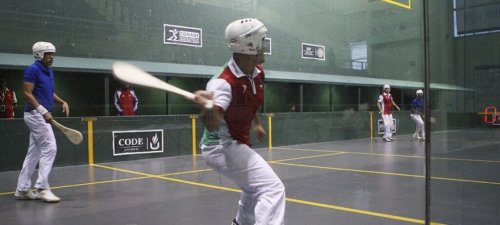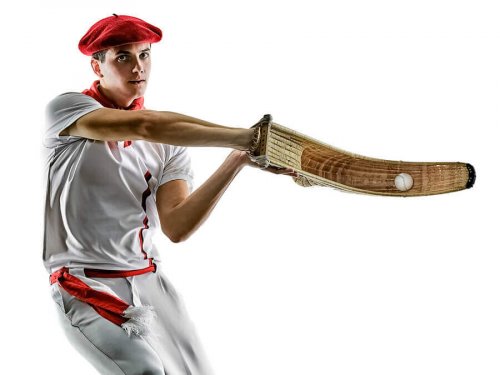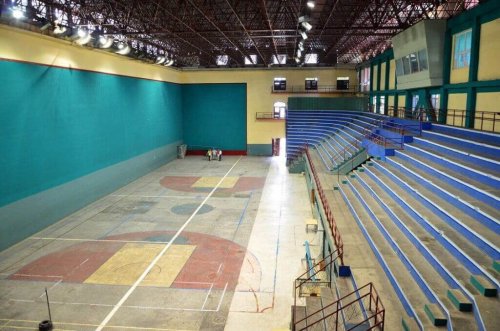The Basics of Basque Pelota
As the name suggests, Basque pelota is a sport from the Basque country in northern Spain. While it’s obviously very popular in its place of origin, it’s also common in countries such as France and Argentina. In this article, we’ll tell you the basics of this centuries-old sport.
Characteristics of Basque pelota
This traditional sport originated in France in the 13th century. The French called it jeu de paume (palm game), and it was the forefather of other ball games, including tennis.
In Spain, the modern version of the sport gained the most popularity in the Basque country, as we mentioned before, as well as in Navarra and La Rioja. Today, it’s supported by the International Federation of Basque Pelota (Federación Internacional de Pelota Vasca, or FIPV) and Spain, France, Argentina, Mexico, Uruguay, Cuba, the United States, and Chile are the main countries were the official competitions are held.
It’s important to note that Basque pelota isn’t an Olympic sport, though it was part of the official games in Paris in 1900. Since then, it has been featured as an exhibition sport at the Olympics in Paris in 1924, Mexico in 1968, and Barcelona in 1992.
To play the game, you need at least two players or two teams. Today, there are four different ways to play Basque pelota.
Trinquet
The length of this kind of court is 28.5 meters. Different variations of Basque pelota are played on trinquet: individual hand-pelota, pairs hand-pelota, paleta cuero (leather bat), xare (the name for the racket, only played by men), paleta goma (rubber bat), and paleta goma maciza (played by men and women).

36-meter fronton (wall)
Different specialties can be played on this type of court, four of them are for men: individual hand-pelota, pairs hand-pelota, paleta cuero (leather bat) and paleta corta (short bat). The other one can be played by men or women and is called paleta goma maciza.
30-meter fronton
The “court” is 30 meters long and 10 meters wide. Here, you can play frontenis (for men and women) or Argentine paleta goma (for men or women).
54-meter fronton
Also known as Jai Alai, this kind of court is only for men’s competitions of cesta punta (literally edged basket). Men wear a special glove that ends in a curved basket type shape, remonte, and pala larga (long bat).

The basics of Basque pelota
Now that you know the different modalities and variations of Basque ball, the next step is to understand the basic rules so that you can try playing.
1. The goal of the game
Basque pelota involves taking turns hitting a ball, which should strike the wall in front of you. The fronton is a court with a high wall at one end called the frontis. Unlike in tennis or paddle ball, there’s no dividing net. Players hit the ball with their hands or with a special wooden racket.
2. Traditional Basque pelota
The 36-meter fronton is considered the “traditional” one in this sport. Many people start playing the game on that kind of court. In addition to the fronton, there’s a high wall on the left side, and the ball can strike there as well.
3. Scoring
For international and official competitions, the first player or team to score 22 points wins. In pick-up games, players decide how high they want to go beforehand.
To start the game, the pelotari (Basque pelota player) launches the ball towards the fronton. The idea is to make it difficult for the opposing team or player to hit it back to the front wall.
4. The serve
As with tennis, the serve is very important for Basque pelota. The serve determines how the game will continue. To serve, the player stands 14 meters from the fronton, throws the ball in the air, and hits it on the way down. The ball has to hit the fronton. If it doesn’t, the serve is invalid.

5. Basque pelota plays
There are different strategies and techniques that players use to score points. A player or a team scores a point when the other team doesn’t return the ball to the fronton. One common play is the pelotazo largo hacia el rebote (roughly translated: a long hit of the ball towards the bounce).
The other common play is la dejada. Here, the player hits the ball with an open hand, which puts a certain spin on the ball. The two-wall play is also classic because the ball gains speed and the opponent can’t hit it on its way towards the stands.
One of the main challenges in Basque pelota is the weight of the balls. Some people say they’re as heavy as rocks: they weight about 110 grams, almost double the weight of a regulation tennis ball.
While Basque pelota isn’t one of the most popular sports in the world, it’s fun, good exercise, and a great social activity. Do some research to see if there are Basque pelota clubs near you and challenge yourself to try something new!
As the name suggests, Basque pelota is a sport from the Basque country in northern Spain. While it’s obviously very popular in its place of origin, it’s also common in countries such as France and Argentina. In this article, we’ll tell you the basics of this centuries-old sport.
Characteristics of Basque pelota
This traditional sport originated in France in the 13th century. The French called it jeu de paume (palm game), and it was the forefather of other ball games, including tennis.
In Spain, the modern version of the sport gained the most popularity in the Basque country, as we mentioned before, as well as in Navarra and La Rioja. Today, it’s supported by the International Federation of Basque Pelota (Federación Internacional de Pelota Vasca, or FIPV) and Spain, France, Argentina, Mexico, Uruguay, Cuba, the United States, and Chile are the main countries were the official competitions are held.
It’s important to note that Basque pelota isn’t an Olympic sport, though it was part of the official games in Paris in 1900. Since then, it has been featured as an exhibition sport at the Olympics in Paris in 1924, Mexico in 1968, and Barcelona in 1992.
To play the game, you need at least two players or two teams. Today, there are four different ways to play Basque pelota.
Trinquet
The length of this kind of court is 28.5 meters. Different variations of Basque pelota are played on trinquet: individual hand-pelota, pairs hand-pelota, paleta cuero (leather bat), xare (the name for the racket, only played by men), paleta goma (rubber bat), and paleta goma maciza (played by men and women).

36-meter fronton (wall)
Different specialties can be played on this type of court, four of them are for men: individual hand-pelota, pairs hand-pelota, paleta cuero (leather bat) and paleta corta (short bat). The other one can be played by men or women and is called paleta goma maciza.
30-meter fronton
The “court” is 30 meters long and 10 meters wide. Here, you can play frontenis (for men and women) or Argentine paleta goma (for men or women).
54-meter fronton
Also known as Jai Alai, this kind of court is only for men’s competitions of cesta punta (literally edged basket). Men wear a special glove that ends in a curved basket type shape, remonte, and pala larga (long bat).

The basics of Basque pelota
Now that you know the different modalities and variations of Basque ball, the next step is to understand the basic rules so that you can try playing.
1. The goal of the game
Basque pelota involves taking turns hitting a ball, which should strike the wall in front of you. The fronton is a court with a high wall at one end called the frontis. Unlike in tennis or paddle ball, there’s no dividing net. Players hit the ball with their hands or with a special wooden racket.
2. Traditional Basque pelota
The 36-meter fronton is considered the “traditional” one in this sport. Many people start playing the game on that kind of court. In addition to the fronton, there’s a high wall on the left side, and the ball can strike there as well.
3. Scoring
For international and official competitions, the first player or team to score 22 points wins. In pick-up games, players decide how high they want to go beforehand.
To start the game, the pelotari (Basque pelota player) launches the ball towards the fronton. The idea is to make it difficult for the opposing team or player to hit it back to the front wall.
4. The serve
As with tennis, the serve is very important for Basque pelota. The serve determines how the game will continue. To serve, the player stands 14 meters from the fronton, throws the ball in the air, and hits it on the way down. The ball has to hit the fronton. If it doesn’t, the serve is invalid.

5. Basque pelota plays
There are different strategies and techniques that players use to score points. A player or a team scores a point when the other team doesn’t return the ball to the fronton. One common play is the pelotazo largo hacia el rebote (roughly translated: a long hit of the ball towards the bounce).
The other common play is la dejada. Here, the player hits the ball with an open hand, which puts a certain spin on the ball. The two-wall play is also classic because the ball gains speed and the opponent can’t hit it on its way towards the stands.
One of the main challenges in Basque pelota is the weight of the balls. Some people say they’re as heavy as rocks: they weight about 110 grams, almost double the weight of a regulation tennis ball.
While Basque pelota isn’t one of the most popular sports in the world, it’s fun, good exercise, and a great social activity. Do some research to see if there are Basque pelota clubs near you and challenge yourself to try something new!
All cited sources were thoroughly reviewed by our team to ensure their quality, reliability, currency, and validity. The bibliography of this article was considered reliable and of academic or scientific accuracy.
- González Abrisketa, O. (2017). Fundación cultural en el deporte: el caso de la pelota vasca. Revista Pueblos y Fronteras Digital. https://doi.org/10.22201/cimsur.18704115e.2006.2.246
This text is provided for informational purposes only and does not replace consultation with a professional. If in doubt, consult your specialist.








